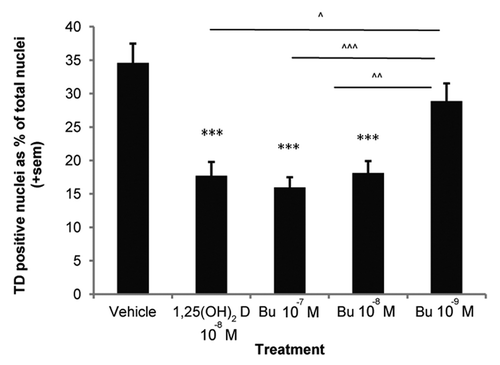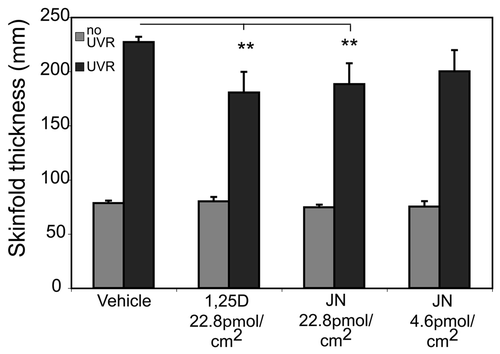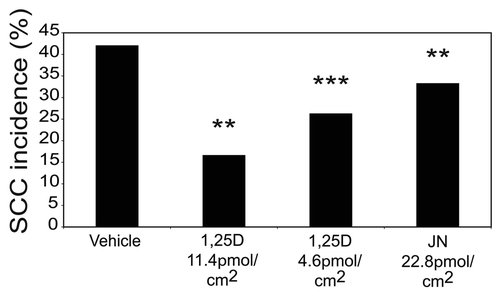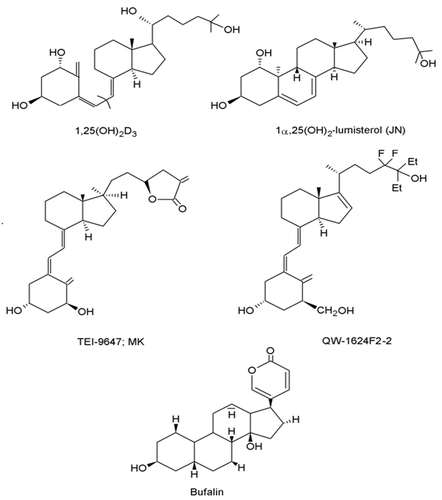Figures & data
Figure 2. Photoprotection against thymine dimers by 1,25(OH)2D3 and Bufalin in human keratinocytes. DNA damage was assessed using a monoclonal antibody to thymine dimers,Citation182 immunohistochemistry and image analysis as previously describedCitation89,Citation94 at 3 h after UV irradiation, in human keratinocytes treated with vehicle, 1,25(OH)2D3 or three concentrations of bufalin and expressed as positively stained nuclei as a percent of total nuclei. The graph illustrates pooled data from a minimum of four independent experiments. *** denotes a significant difference compared with vehicle (***p < 0.001), ^, ^^, ^^^ denotes a significant difference compared with 10−9M bufalin (^p < 0.05, ^^p < 0.01, ^^^p < 0.001).

Figure 3. Reduction of UV-induced IL-6 expression by topical application of 1,25(OH)2D3 in mouse skin. Immunohistochemical detection of IL-6 in Skh:hr1 hairless mice skin was with a monoclonal antibody to IL-6 and a biotinylated secondary rabbit anti-goat IgG. Figures are representative dorsal skin sections (A) non-irradiated skin or (B) after solar simulated radiation followed by 48-h treatment with vehicle or (C) after solar simulated radiation followed by 48-h treatment with 1,25D (22.8 pmol/cm2). Reprinted from The Journal of Steroid Biochemistry and Molecular Biology. R.S. Mason, V.B. Sequeira, K.M. Dixon, C. Gordon-Thomson, K. Pobre, A. Dilley, M.T. Mizwicki, A.W. Norman, D. Feldman, G.M. Halliday, V.E. Reeve (2010).

Figure 4. 1,25(OH)2D3 and JN protect against UV-induced edema. 1,25(OH)2D3 and JN reduce UV-induced edema in Skh:hr1 mouse skin. Mice were exposed to 1 × 3 MEDs (minimal erythemal doses) of solar-simulated UVR (3.98 kJ/m2 UVB and 63.8 kJ/m2 UVA) and were treated topically on the UV-irradiated dorsal surface immediately after UVR exposure with 100 mL of vehicle only, 1,25(OH)2D3, or JN. Edema was measured as dorsal skin-fold thickness in the mice 48 h after UVR exposure. Significantly different from vehicle-treated UV-irradiated mice. **p < 0.01; n = 5. Reproduced from Cancer Prevention Research. K.M. Dixon, A.W. Norman, V.B. Sequeira, R. Mohan, M.S. Rybchyn, V.E. Reeve, G.M. Halliday, R.S. Mason (2011).

Figure 5. 1,25(OH)2D3 and JN protect against chronic UV-induced squamous cell carcinomas (SCC). Groups of 20 mice were exposed to a suberythemal dose of UVR on 5 d/wk for 10 wk. The solar-simulated UVR source was identical to that used in previous studies,Citation88 as described earlier for acute exposures, but the daily dose was lowered to mimic chronic human sunlight exposure without burning. The daily dose provided 0.658 kJ/m2 UVB and 20.30 kJ/m2 UVA, which is approximately one MED (minimal erythemal dose). Incidence of SCC was reduced by 1,25(OH)2D3 and JN at 40-wk time point. SCC incidence was calculated at each weekly time point as the percentage of mice in each group bearing at least 1 SCC. The Mantel-Haenszel log-rank test was performed to determine the difference in risk of developing an SCC between treatment groups and vehicle control. There was a significantly reduced risk of SCC development in both the 1,25(OH)2D3 and JN treatment groups compared with vehicle. The asterisks refer to the incidence risk assessed by the Mantel–Haenszel log-rank test over the whole time course. Significantly different from vehicle. ***p < 0.001; **p < 0.01; n = 20. Reproduced from Cancer Prevention Research. K.M. Dixon, A.W. Norman, V.B. Sequeira, R. Mohan, M.S. Rybchyn, V.E. Reeve, G.M. Halliday, R.S. Mason (2011).

